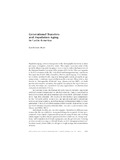Mostrar el registro sencillo del ítem
Generational Transfers and Population Aging in Latin America
| dc.creator | Rosero Bixby, Luis | |
| dc.date.accessioned | 2014-01-10T22:39:43Z | |
| dc.date.available | 2014-01-10T22:39:43Z | |
| dc.date.issued | 2011 | |
| dc.identifier.issn | 0098-7921 | |
| dc.identifier.other | essn: 1728-4457 | |
| dc.identifier.uri | https://hdl.handle.net/10669/8961 | |
| dc.description | artículo (arbitrado)--Universidad de Costa Rica, Instituto de investigaciones en Salud, 2011. Este documento es privado debido a limitaciones de derechos de autor. | es |
| dc.description.abstract | Population aging, a direct consequence of the demographic transition, is often portrayed in negative, even dire terms. This chapter examines some of the probable effects of population aging in Latin America within the framework of the National Transfer Accounts (NTA ) project (NTA 2010).1 The starting point is the NTA estimates of the life-cycle deficit and intergenerational transfers in five countries: Brazil, Chile, Costa Rica, Mexico, and Uruguay. This information is then combined with long-term demographic trends, primarily in age composition, to estimate expected effects on the economy. These effects, also known as “demographic dividends” (e.g., Mason and Lee 2007), are both positive and negative, meaning that population aging in the region involves not only challenges and constraints but also opportunities for development and gains in standards of living. In economic terms, the human life cycle typically includes long initial and final periods of dependency in which production, if any, is insufficient to meet consumption, and an intermediate period in which individuals produce more than they consume. The surplus in intermediate ages compensates for the “life-cycle deficit” at early and late ages through public and private transfers across generations, as well as through reallocations within the same generation. This cycle of deficit–surplus–deficit is neatly depicted by the age curves of consumption and production (labor income) in a given society (Lee, Mason, and Miller 2003). | es |
| dc.description.sponsorship | Universidad de Costa Rica | es |
| dc.language.iso | en_US | es |
| dc.publisher | Population and Development review 37 (Supplement): 143–157 (2011) 143 | es |
| dc.subject | Política Financiera | es |
| dc.subject | Demografía | es |
| dc.subject | Población | es |
| dc.title | Generational Transfers and Population Aging in Latin America | es |
| dc.type | artículo original | |
| dc.description.procedence | UCR::Vicerrectoría de Investigación::Unidades de Investigación::Ciencias de la Salud::Instituto de Investigaciones en Salud (INISA) | es |


